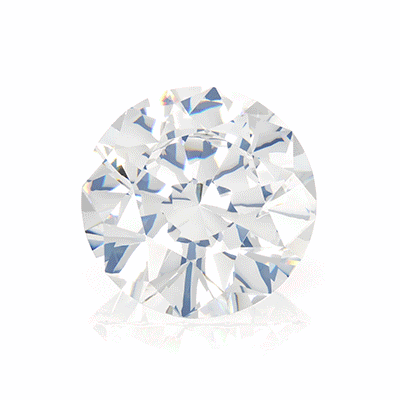Round Brilliant Cut
Short Description
A round brilliant cut diamond has a few features which really set it apart in terms of excellence and prestige. This cut is preferred, and most commonly made when the crystal is in the shape of an octahedron in its natural form; also, two stones are usually cut from one octahedron crystal.
The round brilliant diamond is the most well-known and popular diamond cut, saturating the diamond market with its kind, and for good reason! 70% of all diamonds are cut into this shape because it is the only perfectly symmetrical cut that reflects light equally from within its facets.

Characteristics
The shape resembles that of a cone, enabling maximum light refraction through the top of the diamond and through the septum. The Crown, or upper part of the diamond, consists of 1 table facet, 8 bezel facets, 8 star facets, and 16 upper girdle facets, for a total of 33. On the pavilion, or bottom part of the diamond, there are 16 lower girdle facets, 8 pavilion main facets and 1 culet. See picture below for annotation.

History
First shaped in the 17th century, the Round Brilliant cut truly began its rise in popularity in 1919 with the publication of Marcel Tolkowsky's thesis "Diamond Design: A Study of the Reflection and Refraction of Light in Diamond". The original Tolkowsky specifications (53% table, 59.3% depth, 34.50 crown angle, visible culet) have since been modified because of the technology that is available today. Computers are used to determine the exact characteristics of a diamond, using light to increase the glow in a diamond. Computers have become incredibly useful to Gem cutters, as perfectly cut diamonds are now achievable with ease.
Buying Advice
Round brilliant diamonds have the following dimensions: Table % = 52.4% to 59%, Depth % = 58.7% to 62.3%. Symmetry is perhaps most important with round cut diamonds, than with other shapes, so this is most important to look out for to get maximum elegance, beauty & grace.
Celebrities spotted wearing Round Brilliant cut diamonds
Oscar award winner, Natalie Portman, wears an incredibly elegant engagement ring, designed with an excellent example of the luxurious Round Brilliant diamond, set in an intricate pattern of pave diamonds and a delicate pave diamond band.
Why aren’t all diamonds cut perfectly?
Even with modern techniques & technology, the process of cutting and polishing diamond crystals always result in a dramatic loss of weight; sometimes up to 50%. Usually, the Gem cutter tries to maximize the weight of the diamond while cutting from the original rough crystal, which is usually not ideally proportioned. It can also take a Gem cutter up to 5 times as long to cut a diamond into that notorious, and sought after round brilliant diamond shape, to ideal proportions, with perfect polish and symmetry, than it does to cut into a different shape.




